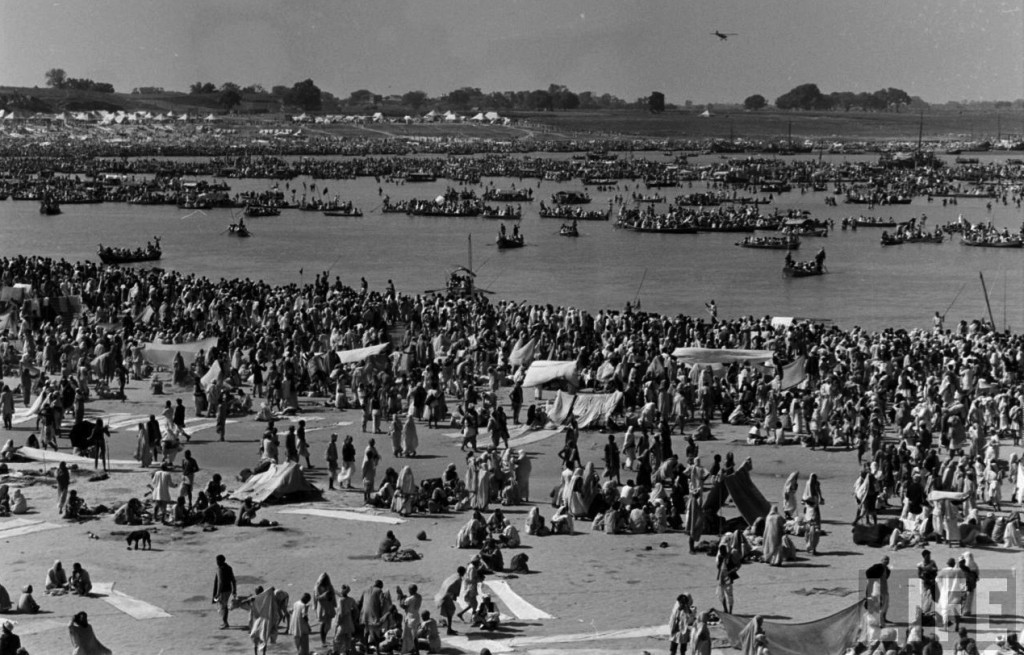In 1960, the great filmmaker Bimal Roy had shot the Kumbh Mela in Allahabad and Haridwar as background for his projected film Amrit Kumbh Ki Khoj Mein based on the story, Amrita Kumbher Sandhaney, by Samaresh Bose. Unfortunately, since the financiers of the Hindi Film Industry were reluctant to put money into the project, the film was never made. Over the years, the footage shot by Bimalda was considered irretrievably lost…
In March 1999, while clearing out Bimalda’s editing room, his son Joy Bimal Roy discovered some old film cans containing black and white negatives in seemingly good condition. But all of Bimalda’s films were stored in a godown. So what was the footage in these cans? Joy began doing a telecine of this footage and discovered he had actually found the lost footage of the Kumbh Mela. But along with the elation of the also discovery came a huge responsibility. What was to be done with the footage?
Joy edited the footage, 78 minutes in all into an 11 minute film. Having found just the picture negatives, the film was naturally silent. As the search began for an appropriate sound track for the film, both Joy and his Sound Designer, Arun Nambiar, decided that the sound track needed to be true to the visuals of the film. Rather than redo a soundtrack for the film, they decided to use songs, bits and pieces of dialogues and sound effects from Bimalda’s films such as a flute piece from Parakh (1960), the mela ambiance from Madhumati (1958), a song from Kabuliwala (1961). The result – a sound track that falls magically into place with the visuals in near perfect sync. Joy also gave the footage a structure by editing it in cycles of day-night and according to the activity happening. Rather than touch the original negative, Joy got a dupe negative made from the entire rushprint and then cut the dupe negative for the final print. Joy acknowledges the help given by Yash Chopra, Adlabs and Kodak in the making of the final film.
I had met Joy then to talk about the making of the film and yes, to see it as well. As one viewed the film and the images, the poetic genius of Bimal Roy came alive. The footage has the touch of a master filmmaker at work. The film once again reaffirms Bimalda’s sensitivity and his expertise in creating a mood. The shots in the film, particularly the boats in the Ganga are beautifully composed. Striking images of people arriving for the mela by train, the mela activity, the huge crowds, a little boy appearing lost and crying, remain in my mind even today.
The film has seen but sporadic screenings in the last 15 years. Unlike today, back then in 2000 there was no proper network in India to screen films such as these apart from a few isolated private screenings. A pity because this is a film every lover of Indian cinema and particularly those who admire Bimalda’s work must see. Today, thanks to YouTube, here is the film.
https://www.youtube.com/watch?v=sBt4dH9IqgU



Absolutely thrilled to watch this Bimalda film. Am sure it would have been a classic again. Was amazed at the shot pictures. Doesn’t appear to be a planned shooting schedule, but random shots. I was taken aback by the orderliness of the crowd- no rushing- no pulling- no attitude display. There was order in the chaos. This was young India then- not yet facing any terrorism, political tantrums. Wish we could go back in time
Thanks for your feedback, Dilip! And glad you liked the film!
What a treat! Watching the visuals of the Kumbh Mela shot in stark black and white.
Composed with gentleness and artistry. Each frame makes you wish this film were longer.
Bimalda was a visionary. Thank you for restoring his art.